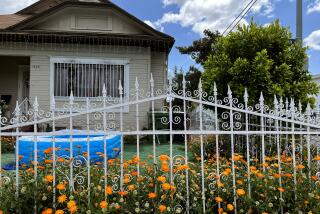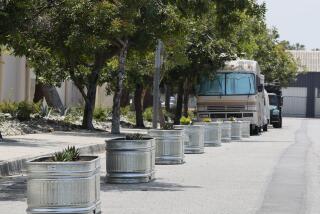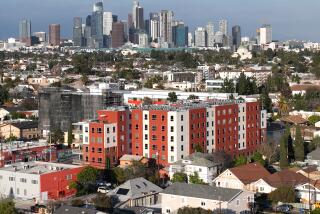Steel Barriers Go Up to Prevent Drug Dealing
Using money from owners of apartments in a once drug-infested Sepulveda neighborhood, authorities on Tuesday began replacing sawhorse barricades credited with reducing street drug dealing with steel barriers they say will help make the improvements permanent.
The barriers--heavy steel posts anchored to the street and equipped with gates to allow emergency vehicles to pass--are being installed in the 12-block area to help keep drive-through drug buyers out of the neighborhood.
The affected area stretches south along Columbus Avenue from Nordhoff Street, and the barriers leave only one entrance to the neighborhood. They are expected to be in place by the end of the week.
Los Angeles Police Capt. Mark Stevens said drug dealing in the area has dropped dramatically since the neighborhood was first barricaded by the city in November.
Stevens said the area--once known as “C Street” because of heavy crack sales--continues to draw some customers and police operating undercover have arrested several people seeking to buy drugs. But he said the days when drug dealers boldly stood on curbs waiting for customers are gone.
“That’s a thing of the past,” Stevens said. “We look at this as a complete success.”
The steel barriers will be installed at four intersections and will cost a total of $6,500. The intersections are: Columbus Avenue and Nordhoff Street; Burnet Avenue and Rayen Street; Memory Park Avenue and Parthenia Street; Columbus Avenue and Parthenia Street. The entrance to the barricaded area is at Rayen Street and Sepulveda Boulevard.
The barriers were paid for by owners of the apartment buildings in the neighborhood and the city has agreed to maintain them.
City Councilman Joel Wachs held a news conference with Stevens on Tuesday as workers installed the first barrier, at Columbus and Nordhoff. Wachs said the barriers could eventually be removed if police believe that drug dealing is unlikely to return to the neighborhood.
“The neighborhood had a very definite character before this,” Wachs said. “It was a veritable drive-through drug store. People were afraid to go out at night.”
The barriers have “liberated the neighborhood,” he said. “We want to be sure that what we have attained here becomes the norm” before any barriers are removed.
Wachs and Stevens said apartment owners and residents in the neighborhood are nearly unanimous in their support for the barriers. Indeed, it took less than six months for owners to raise the money and plan for the barriers.
“We have achieved a remarkable success,” said Tony Swan, who manages five apartment buildings in the neighborhood.
“It is truly a much safer community,” added Phyllis De Obaldia, personnel director at Penny Lane, a home and school for emotionally disturbed children that is located in the neighborhood.
Authorities said police will continue to be highly visible in the community and encourage residents to join Neighborhood Watch and youth programs. Even with the improvements brought by the barriers, some apartments in the neighborhood remain marked by gang graffiti and damaged cars that appear to be abandoned dot the streets. And for some, there is still fear.
One elderly resident said the barriers have improved things but that she still ventures outside only rarely. She asked that her name not be used. “If my name is in the paper, I might get mugged again,” she said, referring to two previous attacks that occurred outside the neighborhood.
“In this neighborhood, it used to be dangerous to walk to church,” the woman said. “Even at 6:30 in the morning, people were lined up on the sidewalks like they were waiting for a parade. But they were dealers.”
“They’re not there anymore” because of the barriers, she said. “But I still don’t go out much.”
The woman, who lives on a fixed income, said the barricades cost her an extra $2 every time she goes to the grocery store because the taxi must take a circuitous route to get to the store only five blocks away. Still, the woman said, the trade-off is worth it.
“It is safer,” she said. “And it’s nice to see the kids able to play in the street.”
More to Read
Sign up for Essential California
The most important California stories and recommendations in your inbox every morning.
You may occasionally receive promotional content from the Los Angeles Times.










